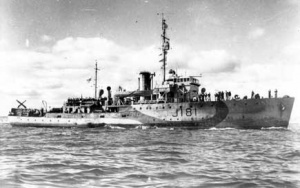HMAS Tamworth was one of sixty Australian minesweepers (commonly known as corvettes) built during the Second World War in Australian shipyards as part of the Commonwealth Government’s wartime shipbuilding program. Twenty (including Tamworth) were built on Admiralty order but crewed and commissioned by the Royal Australian Navy (RAN). Thirty six were built for the RAN and four for the Royal Indian Navy.
Tamworth commissioned at Maryborough on 8 August 1942 under the command of Lieutenant William H Deans RANVR.
Following trials and working up exercises in the Hervey Bay and Sydney areas, Tamworth went to Melbourne early in November 1942 as a convoy escort. From Melbourne it sailed later in the month for Port Adelaide and then to Fremantle.
On 27 January 1943 Tamworth sailed from Fremantle, escorting the tanker SS Athelduke to Diego Garcia. From Diego Garcia it went to Colombo to join the British Eastern Fleet, with which it serveed for two years on Indian Ocean and Persian Gulf convoy escort duty.
While Tamworth was escorting a convoy on 5 October 1943, about 140 miles north of Cape Guardafui in the entrance to the Gulf of Aden, a German submarine of the ‘Monsoon Group’, then operating in the Indian Ocean, torpedoed the Norwegian tanker Anna Knudsen. Fortunately, the ship did not sink and it was assisted to Aden by Tamworth.
Although the Bathurst class were designed as minesweepers, during most of the war they operated as escort and combat vessels. The convoy escort task presented the vessels with a challenge which would have been more appropriately met by long range frigates, had they been available in sufficient numbers. Tamworth’s experience of 16 to 23 February 1944 illustrates this. On the afternoon of 16 February convoy ‘PA 69’ sailed from the Persian Gulf for Aden, having as escorts Tamworth and the Indian ship HMIS Orissa.
The voyage was uneventful until the early hours of 23 February, when the convoy was attacked by the German U-boat U-188 in the entrance to the Gulf of Aden. Three tankers were torpedoed in the attack. The United States (US) ship EG Seubert was sunk. The British vessel San Alvaro caught fire, and as it was considered that it might not sink and would become a danger to navigation, Tamworth sunk it with depth charges and gunfire. The Norwegian tanker Erling Brövig was abandoned in a sinking condition. In the early afternoon of 23 February Tamworth set course for Aden with 133 survivors aboard and entered Aden during the evening. Telegraphist Jock Sutherland recorded the action in his diary as follows:
Another action packed trip! At 03:30 hours, 23-2-44, a terrific explosion, instantly followed by Action Stations. Before we had time to close up there were two or three more violent explosions. At least two of our convoy had been hit, one of the ‘EG Serbert’ blew up a little later; the other, ‘San Alvaro’ beginning to blaze fiercely.
On 17 July 1944 Tamworth, HMAS Ipswich (I), the destroyer HMAS Napier and the tanker SS American Arrow sailed in company from Addu Atoll for Australia. On 21 October 1944 Tamworth departed Fremantle to rejoin the Eastern Fleet, when it sailed in company with Ipswich (I), Napier, HMAS Nepal and the tanker SS British Fusilier. Tamworth arrived at Colombo on 4 November 1944.
Shortly afterwards Tamworth became a unit of the 22nd Minesweeping Flotilla (constituted on 24 November 1944), and the British Pacific Fleet (formed on 22 November 1944). On 26 January 1945 the ship departed Trincomalee for Fremantle, arriving on 9 February.
In March 1945 Tamworth proceeded to the US naval base at Manus Island in the Admiralties Group, to take up duty in the Pacific. Until the end of hostilities on 15 August 1945 it was mainly engaged in escort duty between Manus and the Philippines.
During September 1945 Tamworth, with other units of the 22nd Minesweeping Flotilla, was based at Hong Kong for minesweeping duty and antipiracy patrols. On 28 September at Morotai, it reverted to Australian operational control. The following day it sailed for Australia.
A short period of service in Australian waters followed, including training duties in the Bass Strait area towards the end of the ship’s service.
Tamworth paid off at Sydney on 30 April 1946, having steamed over 125 000 miles. On the same day it was transferred to the Royal Netherlands Navy and renamed Tidore. In December 1949 the ship was transferred to the Indonesian Navy and renamed Pati Unus. It was disposed of in 1969.
Specifications
 |
| Class |
Bathurst Class |
|---|---|
| Type |
Australian Minesweeper |
| Pennant |
J181 |
| Builder |
Walkers Ltd, Maryborough |
| Laid Down |
25 August 1941 |
| Launched |
14 March 1942 |
| Launched by |
Mrs Horsburgh, wife of a Director of Walkers Ltd |
| Commissioned |
8 August 1942 |
| Decommissioned |
30 April 1946 |
| Fate |
On 30 April 1946 transferred to the Royal Netherlands Navy and renamed Tidore. In December 1949 the ship was transferred to the Indonesian Navy and renamed Pati Unus. She was disposed of in 1969. |
| Dimensions & Displacement | |
| Displacement | 650 tons |
| Length | 186 feet |
| Beam | 31 feet |
| Draught | 8 feet 6 inches |
| Performance | |
| Speed | 15 knots |
| Complement | |
| Crew | 85 |
| Propulsion | |
| Machinery | Triple expansion, 2 shafts |
| Horsepower | 2000 |
| Armament | |
| Guns |
|
| Other Armament |
|
| Radars | Types 271 & 291 Radar |
| Awards | |
| Battle Honours |
|
